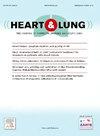Symptom cluster profiles among community-residing older adults with heart failure: Findings from the U.S. health and retirement study
IF 2.6
4区 医学
Q2 CARDIAC & CARDIOVASCULAR SYSTEMS
引用次数: 0
Abstract
Background
As people grow older, years of exposure to cardiovascular risk factors progressively damage the heart’s structure and function, causing the incidence of heart failure (HF) to rise with age. Among older adults with HF, symptoms are manifested as clusters. Few studies have addressed symptoms specifically in older adults with HF, and most have been conducted with small samples.
Objectives
(1) describe symptom cluster profiles in older adults with HF in a nationally representative sample of community-dwelling older adults, and (2) determine the associations between demographic and clinical characteristics and membership in symptom cluster profiles.
Methods
Data from the Health and Retirement Study were used for a secondary analysis. Fatigue, shortness of breath, pain, swelling, depressive symptoms, and dizziness were measured. Latent class analysis was used to identify symptom cluster profiles. Bivariate associations and multinomial logistic regression were used to determine the associations between symptom cluster profiles and demographic and clinical characteristics.
Results
The sample included 690 participants. Three symptom cluster profiles were identified [high-burden, low-burden, and cardiopulmonary-depressive]. Age, gender, BMI, marital status, alcohol consumption, diabetes, lung disease, and arthritis were significantly different across the three profiles. People in the high-burden and cardiopulmonary-depressive profiles, compared to those in low-burden, had higher odds of having lung disease and arthritis, yet lower odds of higher alcohol consumption.
Conclusions
Older adults with HF residing in the community experienced distinct symptom cluster profiles. Research is needed to identify and test targeted interventions for specific symptom cluster profiles.
居住在社区的老年心力衰竭患者的症状群特征:来自美国健康和退休研究的发现
随着人们年龄的增长,多年暴露于心血管危险因素会逐渐损害心脏的结构和功能,导致心力衰竭(HF)的发病率随着年龄的增长而上升。在老年HF患者中,症状表现为聚集性。很少有研究专门针对老年心衰患者的症状,而且大多数研究都是在小样本中进行的。目的(1)在全国具有代表性的社区居住老年人样本中描述老年心衰患者的症状群特征;(2)确定人口统计学和临床特征与症状群特征成员之间的关系。方法采用健康与退休研究的数据进行二次分析。测量了疲劳、呼吸短促、疼痛、肿胀、抑郁症状和头晕。潜在类分析用于识别症状聚类概况。使用双变量关联和多项逻辑回归来确定症状聚类概况与人口统计学和临床特征之间的关联。结果共纳入690人。确定了三种症状群特征[高负担、低负担和心肺抑郁]。年龄、性别、身体质量指数、婚姻状况、饮酒、糖尿病、肺病和关节炎在三种情况下存在显著差异。与低负担人群相比,高负担人群和心肺抑郁人群患肺病和关节炎的几率更高,但酗酒的几率更低。结论居住在社区的成年HF患者具有明显的症状群特征。需要进行研究,以确定和测试针对特定症状群的有针对性的干预措施。
本文章由计算机程序翻译,如有差异,请以英文原文为准。
求助全文
约1分钟内获得全文
求助全文
来源期刊

Heart & Lung
医学-呼吸系统
CiteScore
4.60
自引率
3.60%
发文量
184
审稿时长
35 days
期刊介绍:
Heart & Lung: The Journal of Cardiopulmonary and Acute Care, the official publication of The American Association of Heart Failure Nurses, presents original, peer-reviewed articles on techniques, advances, investigations, and observations related to the care of patients with acute and critical illness and patients with chronic cardiac or pulmonary disorders.
The Journal''s acute care articles focus on the care of hospitalized patients, including those in the critical and acute care settings. Because most patients who are hospitalized in acute and critical care settings have chronic conditions, we are also interested in the chronically critically ill, the care of patients with chronic cardiopulmonary disorders, their rehabilitation, and disease prevention. The Journal''s heart failure articles focus on all aspects of the care of patients with this condition. Manuscripts that are relevant to populations across the human lifespan are welcome.
 求助内容:
求助内容: 应助结果提醒方式:
应助结果提醒方式:


